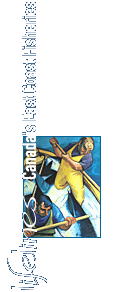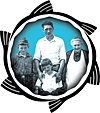"And, my dear, I can remember the flour bag. We used to have table
cloths made out of it, and I used to wash them and starch them and
mix up the flour and starch them. And iron them and put them on
the table!"
(Mrs. Winnie Prior, Jersey Harbour and Grand
Bank, Fortune Bay)
 ue largely to the nature
of the "truck" system and the sparseness of the island's population,
the development of specialized trades was slow. As a result, fishing
families did a wide range of work in order to make their livelihood.
The family's diet of fish and staples bought from the merchant was
supplemented by gardening, picking wild berries, hunting seabirds
and rabbits, and raising animals. After each fishing season, in
addition to repairing his fishing gear, a man might cut timber,
erect and repair buildings, build boats and furniture, or make
barrels. He might go to the lumberwoods or engage in the seal
fishery in order to bring home some extra cash. ue largely to the nature
of the "truck" system and the sparseness of the island's population,
the development of specialized trades was slow. As a result, fishing
families did a wide range of work in order to make their livelihood.
The family's diet of fish and staples bought from the merchant was
supplemented by gardening, picking wild berries, hunting seabirds
and rabbits, and raising animals. After each fishing season, in
addition to repairing his fishing gear, a man might cut timber,
erect and repair buildings, build boats and furniture, or make
barrels. He might go to the lumberwoods or engage in the seal
fishery in order to bring home some extra cash.
|
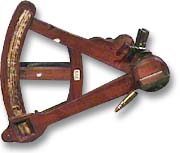
|

Navigational Instrument
Homemade
Navigational instrument made from various recycled materials, circa 1900
(Newfoundland Museum)
|
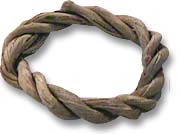
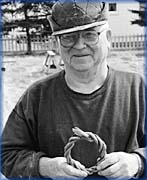
Mr. George Penney holding
his withe, circa 1993.
Photo: Walter Peddle
|

Withe
Homemade
One of a pair of "withes" made by Mr. George Penney in Keels,
Bonavista Bay, circa 1935. Withes were used by Bonavista Bay
fishermen to secure a boat's oars to the tholepins, and as handles
for caskets. They were made from witrods - the long tough stems
of the "gad" bush which commonly grows along the banks of local brooks.
Two witrods with their bark left on were twisted around one another.
Soaking in brine would further toughen a withe.
(Newfoundland Museum)
"Not everyone could do it. There's a technique to it, twist too
hard and it would break off."
(Mr. George Penney, Keels, Bonavista Bay
and Catalina, Trinity Bay)
|
|
|
